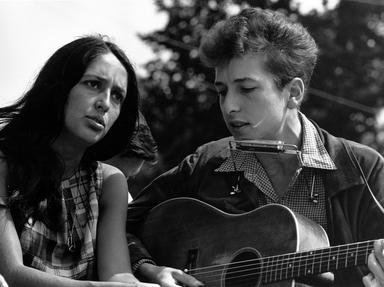Quiz Answer Key and Fun Facts
1. On Sunday, July 25, 1965, Bob Dylan walked onto the stage of a festival in Rhode Island with an electric guitar and stunned the music world. Which festival was it?
2. One of the songs on Bob Dylan's "Bringing It All Back Home" album would be the last song he sang at a Newport Folk Festival in the 20th century. Which jangly song was it?
3. Bob Dylan showed his electric side early in 1965 with the release of a single that was grounded in the works of Jack Kerouac, Woody Guthrie and Pete Seeger, with an electrically-amplified band backing him up. Which song was it?
4. No matter how serious the theme of Bob Dylan's albums, he usually included a nonsensical song. Such was the case with "Bob Dylan's 115th Dream" on his "Bringing It All Back Home" album. It was told from the point of view of a sailor on a ship about to discover America. Which ship was the sailor on, pilgrim?
5. Bob Dylan used several of the songs of the "Bringing It All Back Home" album to punch holes in preconceptions and icons including what might be considered the final goal. Which of these songs describes it?
6. Putting a fine point on his plan to change musical genres, Bob Dylan penned these lyrics to one of his songs: "Leave your stepping stones behind, something calls for you. Forget the dead you've left, they will not follow you". Which song was it?
7. In August, 1966, Columbia Records released Bob Dylan's "Highway 61 Revisited" album. The lead song would become one of Dylan's most famous, and in 2010, "Rolling Stone" magazine named it the best rock and roll song, ever! How does it feel, Bob?
8. Could anyone but Bob Dylan successfully blend Einstein, Noah, Romeo, Cinderella and Ezra Pound into a song? Which song from "Highway 61 Revisited" am I referring to?
9. Bob Dylan's most controversial song was the lead track on his 1966 "Blonde on Blonde" album. Which song was it?
10. Not only could Bob Dylan write protest songs and surrealistic songs, he could write a love song, which he did for his wife and used it as the final song on the "Blonde on Blonde" album. Which of these songs was the one written for Sara?
Source: Author
CmdrK
This quiz was reviewed by FunTrivia editor
agony before going online.
Any errors found in FunTrivia content are routinely corrected through our feedback system.

